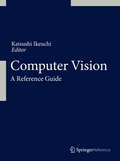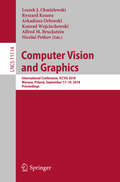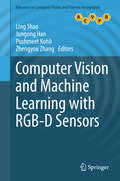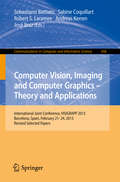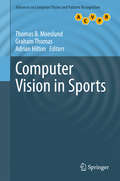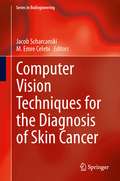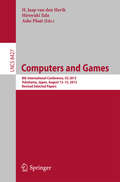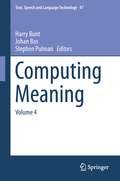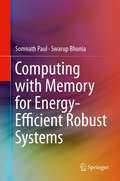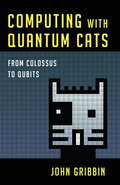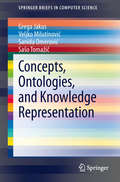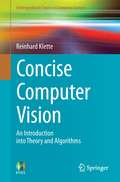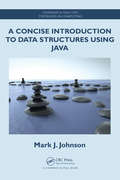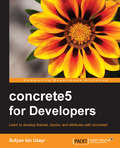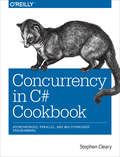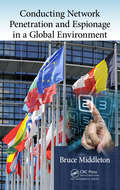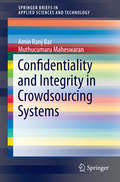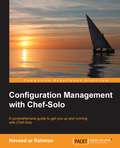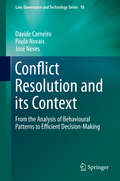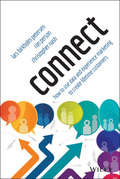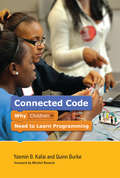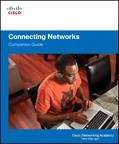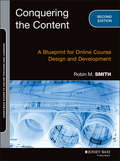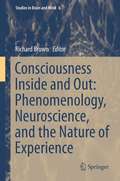- Table View
- List View
Computer Vision: A Reference Guide
by Katsushi IkeuchiThis comprehensive reference provides easy access to relevant information on all aspects of Computer Vision. An A-Z format of over 240 entries offers a diverse range of topics for those seeking entry into any aspect within the broad field of Computer Vision. Over 200 Authors from both industry and academia contributed to this volume. Each entry includes synonyms, a definition and discussion of the topic, and a robust bibliography. Extensive cross-references to other entries support efficient, user-friendly searches for immediate access to relevant information Entries were peer-reviewed by a distinguished international advisory board, both scientifically and geographically diverse, ensuring balanced coverage. Over 3700 bibliographic references for further reading enable deeper exploration into any of the topics covered. The content of Computer Vision: A Reference Guide is expository and tutorial, making the book a practical resource for students who are considering entering the field, as well as professionals in other fields who need to access this vital information but may not have the time to work their way through an entire text on their topic of interest.
Computer Vision and Graphics: International Conference, Iccvg 2014, Warsaw, Poland, September 15-17, 2014, Proceedings (Lecture Notes in Computer Science #8671)
by Nicolai Petkov Alfred M. Bruckstein Konrad Wojciechowski Arkadiusz Orłowski Ryszard Kozera Leszek J. ChmielewskiThis book constitutes the refereed proceedings of the International Conference on Computer Vision and Graphics, ICCVG 2018, held in Warsaw, Poland, in September 2018. The 45 full papers were selected from 117 submissions. The contributions are thematically arranged as follows: computer graphics, image quality and graphic, user interfaces, object classification and features, 3D and stereo image processing, low-level and middle-level image processing, medical image analysis, motion analysis and tracking, security and protection, pattern recognition and new concepts in classification.
Computer Vision and Machine Learning with RGB-D Sensors (Advances in Computer Vision and Pattern Recognition)
by Ling Shao Pushmeet Kohli Jungong Han Zhengyou ZhangThis book presents an interdisciplinary selection of cutting-edge research on RGB-D based computer vision. Features: discusses the calibration of color and depth cameras, the reduction of noise on depth maps and methods for capturing human performance in 3D; reviews a selection of applications which use RGB-D information to reconstruct human figures, evaluate energy consumption and obtain accurate action classification; presents an approach for 3D object retrieval and for the reconstruction of gas flow from multiple Kinect cameras; describes an RGB-D computer vision system designed to assist the visually impaired and another for smart-environment sensing to assist elderly and disabled people; examines the effective features that characterize static hand poses and introduces a unified framework to enforce both temporal and spatial constraints for hand parsing; proposes a new classifier architecture for real-time hand pose recognition and a novel hand segmentation and gesture recognition system.
Computer Vision, Imaging and Computer Graphics: International Joint Conference, VISIGRAPP 2013, Barcelona, Spain, February 21-24, 2013, Revised Selected Papers (Communications in Computer and Information Science #458)
by Sebastiano Battiato, Sabine Coquillart, Robert S. Laramee, Andreas Kerren and José BrazThis book constitutes the refereed proceedings of the 8th International Conference, VISIGRAPP 2013 consisting of the Joint Conferences on Computer Vision (VISAPP), the International Conference on Computer Graphics, GRAPP 2013, and the International Conference on Information Visualization IVAPP 2013, held in Barcelona, Spain, in February 2013. The 15 revised full papers presented were carefully reviewed and selected from 445 submissions. The papers are organized in topical sections on theory and applications in computer vision, image analysis, computer graphics, and information visualization.
Computer Vision in Sports (Advances in Computer Vision and Pattern Recognition)
by Graham Thomas Thomas B. Moeslund Adrian HiltonThe first book of its kind devoted to this topic, this comprehensive text/reference presents state-of-the-art research and reviews current challenges in the application of computer vision to problems in sports. Opening with a detailed introduction to the use of computer vision across the entire life-cycle of a sports event, the text then progresses to examine cutting-edge techniques for tracking the ball, obtaining the whereabouts and pose of the players, and identifying the sport being played from video footage. The work concludes by investigating a selection of systems for the automatic analysis and classification of sports play. The insights provided by this pioneering collection will be of great interest to researchers and practitioners involved in computer vision, sports analysis and media production.
Computer Vision Techniques for the Diagnosis of Skin Cancer (Series in BioEngineering)
by M. Emre Celebi Jacob ScharcanskiThe goal of this volume is to summarize the state-of-the-art in the utilization of computer vision techniques in the diagnosis of skin cancer. Malignant melanoma is one of the most rapidly increasing cancers in the world. Early diagnosis is particularly important since melanoma can be cured with a simple excision if detected early. In recent years, dermoscopy has proved valuable in visualizing the morphological structures in pigmented lesions. However, it has also been shown that dermoscopy is difficult to learn and subjective. Newer technologies such as infrared imaging, multispectral imaging, and confocal microscopy, have recently come to the forefront in providing greater diagnostic accuracy. These imaging technologies presented in this book can serve as an adjunct to physicians and provide automated skin cancer screening. Although computerized techniques cannot as yet provide a definitive diagnosis, they can be used to improve biopsy decision-making as well as early melanoma detection, especially for patients with multiple atypical nevi.
Computers and Games: 8th International Conference, CG 2013, Yokohama, Japan, August 13-15, 2013, Revised Selected Papers (Lecture Notes in Computer Science #8427)
by Hiroyuki Iida Aske Plaat H. Jaap HerikThis book constitutes the thoroughly refereed post-conference proceedings of the 8th International Conference on Computers and Games, CG 2013, held in Yokohama, Japan, in August 2013, in conjunction with the 17th Computer and Games Tournament and the 20th World Computer-Chess Championship. The 21 papers presented were carefully reviewed and selected for inclusion in this book. They cover a wide range of topics which are grouped into five classes: Monte Carlo Tree Search and its enhancements; solving and searching; analysis of game characteristic; new approaches; and serious games.
Computing for Biologists
by Ran Libeskind-Hadas Eliot BushComputing is revolutionizing the practice of biology. This book, which assumes no prior computing experience, provides students with the tools to write their own Python programs and to understand fundamental concepts in computational biology and bioinformatics. Each major part of the book begins with a compelling biological question, followed by the algorithmic ideas and programming tools necessary to explore it: the origins of pathogenicity are examined using gene finding, the evolutionary history of sex determination systems is studied using sequence alignment, and the origin of modern humans is addressed using phylogenetic methods. In addition to providing general programming skills, this book explores the design of efficient algorithms, simulation, NP-hardness, and the maximum likelihood method, among other key concepts and methods. Easy-to-read and designed to equip students with the skills to write programs for solving a range of biological problems, the book is accompanied by numerous programming exercises, available at www. cs. hmc. edu/CFB.
Computing Meaning: Volume 4 (Text, Speech and Language Technology #47)
by Harry Bunt Johan Bos Stephen PulmanThis book is a collection of papers by leading researchers in computational semantics. It presents a state-of-the-art overview of recent and current research in computational semantics, including descriptions of new methods for constructing and improving resources for semantic computation, such as WordNet, VerbNet, and semantically annotated corpora. It also presents new statistical methods in semantic computation, such as the application of distributional semantics in the compositional calculation of sentence meanings. Computing the meaning of sentences, texts, and spoken or texted dialogue is the ultimate challenge in natural language processing, and the key to a wide range of exciting applications. The breadth and depth of coverage of this book makes it suitable as a reference and overview of the state of the field for researchers in Computational Linguistics, Semantics, Computer Science, Cognitive Science, and Artificial Intelligence.
Computing with Memory for Energy-Efficient Robust Systems
by Swarup Bhunia Somnath PaulThis book analyzes energy and reliability as major challenges faced by designers of computing frameworks in the nanometer technology regime. The authors describe the existing solutions to address these challenges and then reveal a new reconfigurable computing platform, which leverages high-density nanoscale memory for both data storage and computation to maximize the energy-efficiency and reliability. The energy and reliability benefits of this new paradigm are illustrated and the design challenges are discussed. Various hardware and software aspects of this exciting computing paradigm are described, particularly with respect to hardware-software co-designed frameworks, where the hardware unit can be reconfigured to mimic diverse application behavior. Finally, the energy-efficiency of the paradigm described is compared with other, well-known reconfigurable computing platforms.
Computing with Quantum Cats
by John GribbinA mind-blowing glimpse into the near future, where quantum computing will have world-transforming effects.The quantum computer is no longer the stuff of science fiction. Pioneering physicists are on the brink of unlocking a new quantum universe which provides a better representation of reality than our everyday experiences and common sense ever could. The birth of quantum computers - which, like Schrödinger's famous "dead and alive" cat, rely on entities like electrons, photons, or atoms existing in two states at the same time - is set to turn the computing world on its head.In his fascinating study of this cutting-edge technology, John Gribbin updates his previous views on the nature of quantum reality, arguing for a universe of many parallel worlds where "everything is real." Looking back to Alan Turing's work on the Enigma machine and the first electronic computer, Gribbin explains how quantum theory developed to make quantum computers work in practice as well as in principle. He takes us beyond the arena of theoretical physics to explore their practical applications - from machines which learn through "intuition" and trial and error to unhackable laptops and smartphones. And he investigates the potential for this extraordinary science to create a world where communication occurs faster than light and teleportation is possible.This is an exciting insider's look at the new frontier of computer science and its revolutionary implications.
Concepts, Ontologies, and Knowledge Representation (SpringerBriefs in Computer Science)
by Veljko Milutinović Sanida Omerovic Grega Jakus Saso TomazicRecording knowledge in a common framework that would make it possible to seamlessly share global knowledge remains an important challenge for researchers. This brief examines several ideas about the representation of knowledge addressing this challenge. A widespread general agreement is followed that states uniform knowledge representation should be achievable by using ontologies populated with concepts. A separate chapter is dedicated to each of the three introduced topics, following a uniform outline: definition, organization, and use. This brief is intended for those who want to get to know the field of knowledge representation quickly, or would like to be up to date with current developments in the field. It is also useful for those dealing with implementation as examples of numerous operational systems are also given.
Concise Computer Vision: An Introduction into Theory and Algorithms (Undergraduate Topics in Computer Science)
by Reinhard KletteThis textbook provides an accessible general introduction to the essential topics in computer vision. Classroom-tested programming exercises and review questions are also supplied at the end of each chapter. Features: provides an introduction to the basic notation and mathematical concepts for describing an image and the key concepts for mapping an image into an image; explains the topologic and geometric basics for analysing image regions and distributions of image values and discusses identifying patterns in an image; introduces optic flow for representing dense motion and various topics in sparse motion analysis; describes special approaches for image binarization and segmentation of still images or video frames; examines the basic components of a computer vision system; reviews different techniques for vision-based 3D shape reconstruction; includes a discussion of stereo matchers and the phase-congruency model for image features; presents an introduction into classification and learning.
A Concise Introduction to Data Structures using Java (Chapman And Hall/crc Textbooks In Computing Ser. #11)
by Mark J. JohnsonA student-friendly text, A Concise Introduction to Data Structures Using Java takes a developmental approach, starting with simpler concepts first and then building toward greater complexity. Important topics, such as linked lists, are introduced gradually and revisited with increasing depth. More code and guidance are provided at the beginning, al
concrete5 for Developers
by Sufyan Bin UzayrWhether you have had some previous experience with concrete5 or are entirely new to it, this book will help you understand all that you need to know in order to get started with concrete5 development. A background in PHP is required; some knowledge of HTML/CSS is needed in order to fully grasp the concepts underlying concrete5 theme development.
Concurrency in C# Cookbook
by Stephen ClearyIf you're one of the many developers uncertain about concurrent and multithreaded development, this practical cookbook will change your mind. With more than 75 code-rich recipes, author Stephen Cleary demonstrates parallel processing and asynchronous programming techniques, using libraries and language features in .NET 4.5 and C# 5.0.Concurrency is becoming more common in responsive and scalable application development, but it's been extremely difficult to code. The detailed solutions in this cookbook show you how modern tools raise the level of abstraction, making concurrency much easier than before. Complete with ready-to-use code and discussions about how and why the solution works, you get recipes for using:async and await for asynchronous operationsParallel programming with the Task Parallel LibraryThe TPL Dataflow library for creating dataflow pipelinesCapabilities that Reactive Extensions build on top of LINQUnit testing with concurrent codeInterop scenarios for combining concurrent approachesImmutable, threadsafe, and producer/consumer collectionsCancellation support in your concurrent codeAsynchronous-friendly Object-Oriented ProgrammingThread synchronization for accessing data
Conducting Network Penetration and Espionage in a Global Environment
by Bruce MiddletonWhen it's all said and done, penetration testing remains the most effective way to identify security vulnerabilities in computer networks. Conducting Network Penetration and Espionage in a Global Environment provides detailed guidance on how to perform effective penetration testing of computer networks-using free, open source, and commercially avai
Confidentiality and Integrity in Crowdsourcing Systems (SpringerBriefs in Applied Sciences and Technology)
by Amin Ranj Bar Muthucumaru MaheswaranConfidentiality and Integrity in Crowdsourcing Systems focuses on identity, privacy, and security related issues in crowdsourcing systems and in particular the confidentiality and integrity of online data created via crowdsourcing. This book begins with an introduction to crowdsourcing and then covers the privacy and security challenges of Confidentiality. The book examines integrity in these systems and the management and control of crowdsourcing systems.
Configuration Management with Chef-Solo
by Naveed Ur RahmanThis is a step-by-step guide, full of hands-on examples of real-world deployment tasks. Each topic is explained and placed in context, while also pointing out the key details of the concepts used. This book is aimed at system administrators and system engineers who have an understanding of configuration management tools and infrastructure. For novice administrators, it contains easy-to-use application recipes to get started immediately.
Conflict Resolution and its Context: From the Analysis of Behavioural Patterns to Efficient Decision-Making (Law, Governance and Technology Series #18)
by Davide Carneiro Paulo Novais José NevesThis book studies how technological solutions can be used to alleviate the current state of legal systems, with their clogged up courtrooms and inefficient conflict resolution methods. It reviews the shortcomings and disadvantages of traditional and alternative conflict resolution methods and turns to Artificial Intelligence for problem-solving techniques and solutions. The book is divided into four parts. The first part presents a general and systematic analysis of the current state of the legal systems, identifying the main problems and their causes It then moves on to present UM Court: a framework for testing and prototyping conflict resolution services. This framework was developed with the objective of using Artificial Intelligence techniques to build a service environment for conflict resolution. The third part of the book takes a step into the future by analyzing the use of Intelligent Environments in the support of conflict management and resolution. It describes the approach taken and the experiments performed in the Intelligent Systems Lab of the University of Minho. The final part of the book contains the conclusions and shows the potential advantages of the use of Intelligent Environments as a way to implement better conflict resolution procedures (virtual or real), in which all the participants have access to more and better information and are able to take better informed decisions.
Connect: How to Use Data and Experience Marketing to Create Lifetime Customers
by Ron Person Lars Birkholm Petersen Christopher NashConnect and engage across channels with the new customers Connect is the ultimate marketing guide to becoming more relevant, effective, and successful within the new marketplace. Written by a team of marketing experts serving Fortune 500 brands, this book outlines the massive paradigm shift currently taking place within the industry, and provides the insight and perspective marketers need to stay on board. Readers will find guidance toward reaching a customer base that sees marketers as an unnecessary annoyance, and strategies for engaging those customers at touch points throughout the customer lifecycle. The book's scope encompasses both digital and real-life avenues, discussing the new ways of thinking and the new tools and processes that allow marketers to function in the new era where digital customer experiences are increasingly important. Marketing is undergoing a revolution to rival the impact of Gutenberg's printing press. Customers are in control, with more choice and more access than ever before, and they refuse to be "sold to" or "managed." Many marketing professionals are flailing for a new strategy while the winners are clearly jumping ahead - Connect takes readers inside the winners' world to learn the approach that's engaging the new consumer. Discover the technology and processes that allow marketers to remain relevant Craft a personal, relevant, and accessible customer journey that engages the connected customer Keep in touch throughout the customer's life cycle, both online and offline Link digital goals and metrics to business objectives for a more relevant strategy Smart marketers have moved to a higher level that achieves business objectives while increasing relevance to the customer. Connect provides readers a roadmap to this new approach, and the tools that make it work.
Connected Code: Why Children Need to Learn Programming (The John D. and Catherine T. MacArthur Foundation Series on Digital Media and Learning)
by Yasmin B. Kafai Quinn BurkeWhy every child needs to learn to code: the shift from “computational thinking” to computational participation.Coding, once considered an arcane craft practiced by solitary techies, is now recognized by educators and theorists as a crucial skill, even a new literacy, for all children. Programming is often promoted in K-12 schools as a way to encourage “computational thinking”—which has now become the umbrella term for understanding what computer science has to contribute to reasoning and communicating in an ever-increasingly digital world.In Connected Code, Yasmin Kafai and Quinn Burke argue that although computational thinking represents an excellent starting point, the broader conception of “computational participation” better captures the twenty-first-century reality. Computational participation moves beyond the individual to focus on wider social networks and a DIY culture of digital “making.”Kafai and Burke describe contemporary examples of computational participation: students who code not for the sake of coding but to create games, stories, and animations to share; the emergence of youth programming communities; the practices and ethical challenges of remixing (rather than starting from scratch); and the move beyond stationary screens to programmable toys, tools, and textiles.
Connecting Networks Companion Guide
by Cisco Networking AcademyThis course discusses the WAN technologies and network services required by converged applications in a complex network. The course allows you to understand the selection criteria of network devices and WAN technologies to meet network requirements. You will learn how to configure and troubleshoot network devices and resolve common issues with data link protocols. You will also develop the knowledge and skills needed to implement IPSec and virtual private network (VPN) operations in a complex network.
Conquering the Content: A Blueprint for Online Course Design and Development (Jossey-Bass Guides to Online Teaching and Learning)
by Robin M. SmithPut your course online now, without sacrificing pedagogical quality Conquering the Content: A Blueprint for Online Course Design and Development, Second Edition is a highly practical guide to creating online courses. With guidance on incorporating learning theory into online course content, as well as a host of templates, learning guides, and sample files, this book furnishes instructors and instructional designers with the information and tools they need to design and develop their course content to better serve online students. This second edition introduces relevance statements and time-saving tips as well as content maps which provide a scaffold for content organization and help students anchor the topics in their memories for retrieval. Readers will gain expert insight and best practices for designing within the rapidly changing online learning environment and learn to incorporate recent advances that can improve student outcomes. Because the book is designed to focus on online teaching pedagogy, it won't go out of date as specific tools change. Nearly one-third of all students in higher education are taking at least one online class, and online hybrid classes are becoming more widespread. Distance learning is becoming the norm, but creating an online class is more complex than just posting course content on a website. Conquering the Content demonstrates how instructors can best revamp their course content to suit the online learning environment, and provides the tools and resources instructors need to transfer their effectiveness from the classroom to the online environment. Learn how to: Create student-friendly navigation structures that support what is known about the brain and learning Organize content based on priority, flow, and easy navigation Create assessments that work within the parameters of an online course "Chunk" information to facilitate better processing Time is of the essence in getting a course online, but it's important that pedagogy not get lost in the crush of new content. Course design is just as critical as course content when it comes to distance learning outcomes, and Conquering the Content provides a holistic and practical approach to effective online course development.
Consciousness Inside and Out: Phenomenology, Neuroscience, And The Nature Of Experience (Studies in Brain and Mind #6)
by Richard BrownThis volume is product of the third online consciousness conference, held at http://consciousnessonline.com in February and March 2011. Chapters range over epistemological issues in the science and philosophy of perception, what neuroscience can do to help us solve philosophical issues in the philosophy of mind, what the true nature of black and white vision, pain, auditory, olfactory, or multi-modal experiences are, to higher-order theories of consciousness, synesthesia, among others. Each chapter includes a target article, commentaries, and in most cases, a final response from the author. Though wide-ranging all of the papers aim to understand consciousness both from the inside, as we experience it, and from the outside as we encounter it in our science. The Online Consciousness Conference, founded and organized by Richard Brown, is dedicated to the rigorous study of consciousness and mind. The goal is to bring philosophers, scientists, and interested lay persons together in an online venue to promote high-level discussion and exchanging of views, ideas and data related to the scientific and philosophical study of consciousness.
